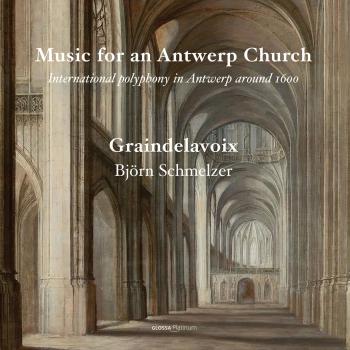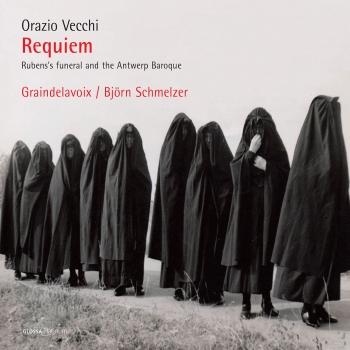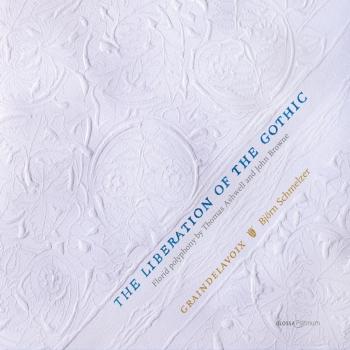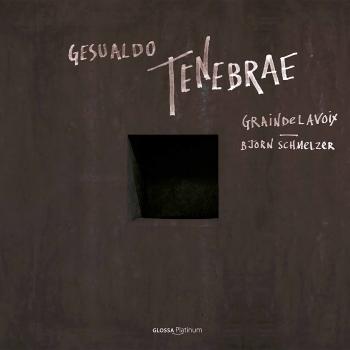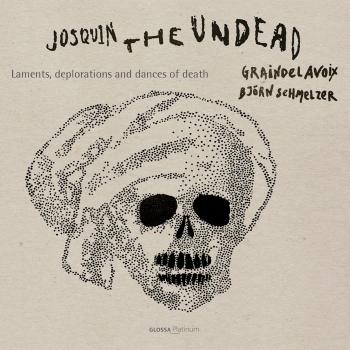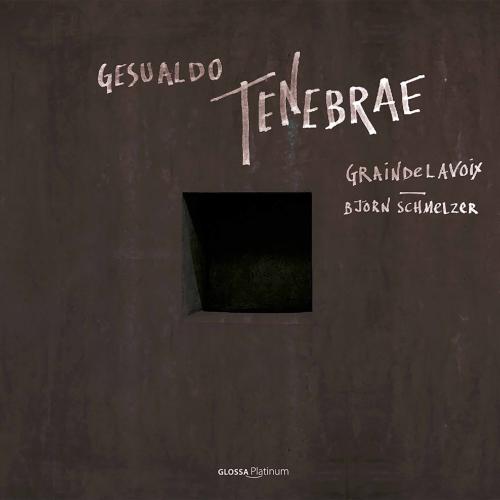
Tenebrae Graindelavoix & Björn Schmelzer
Album info
Album-Release:
2020
HRA-Release:
17.04.2020
Label: Glossa
Genre: Classical
Subgenre: Vocal
Artist: Graindelavoix & Björn Schmelzer
Composer: Carlo Gesualdo (1566-1613)
Album including Album cover Booklet (PDF)
- Carlo Gesualdo (1566 - 1613): Feria Quinta – Tenebrae Responsoria for Maundy Thursday:
- 1 Aleph. Quomodo sedet sola civitas 03:33
- 2 Tenebrae responsoria for Maundy Thursday: No. 1, In monte Oliveti 05:01
- 3 Zain. Recordata est Hierusalem 03:45
- 4 Tenebrae responsoria for Maundy Thursday: No. 2, Tristis est anima mea 05:09
- 5 Lamed. O vos omnes, qui transitis per viam 02:41
- 6 Tenebrae responsoria for Maundy Thursday: No. 3, Ecce vidimus eum 08:08
- 7 Exaudi, Deus, orationem meam 02:39
- 8 Tenebrae responsoria for Maundy Thursday: No. 4, Amicus meus 03:39
- 9 Tenebrae responsoria for Maundy Thursday: No. 5, Iudas mercator pessimus 02:13
- 10 Tenebrae responsoria for Maundy Thursday: No. 6, Unus ex discipulis meis 06:15
- 11 Tenebrae responsoria for Maundy Thursday: No. 7, Eram quasi agnus 05:55
- 12 Tenebrae responsoria for Maundy Thursday: No. 8, Una hora 03:31
- 13 Tenebrae responsoria for Maundy Thursday: No. 9, Seniores populi 05:53
- 14 Christus factus est 02:38
- 15 Tenebrae responsoria: Miserere mei Deus 10:13
- Feria Sexta – Tenebrae Responsoria for Good Friday:
- 16 Heth. Cogitavit Dominus dissipare 03:19
- 17 Tenebrae responsoria for Holy Friday: No. 1, Omnes amici mei 05:01
- 18 Lamed. Matribus suis dixerunt 03:09
- 19 Tenebrae responsoria for Holy Friday: No. 2, Velum templi scissum est 04:41
- 20 Aleph. Ego vir videns paupertatem 04:42
- 21 Tenebrae responsoria for Holy Friday: No. 3, Vinea mea electa 05:37
- 22 Tenebrae responsoria for Holy Friday: No. 4, Tamquam ad latronem 03:44
- 23 Tenebrae responsoria for Holy Friday: No. 5, Tenebrae factae sunt 05:53
- 24 Tenebrae responsoria for Holy Friday: No. 6, Animam meam dilectam tradidi 08:31
- 25 Tenebrae responsoria for Holy Friday: No. 7, Tradiderunt me in manus impiorum 03:17
- 26 Tenebrae responsoria for Holy Friday: No. 8, Iesum tradidit impius 04:57
- 27 Tenebrae responsoria for Holy Friday: No. 9, Caligaverunt oculi mei 10:00
- Sabbato Sancto – Tenebrae Responsoria for Holy Saturday:
- 28 Heth. Misericordiae Domini 02:52
- 29 Tenebrae responsoria for Holy Saturday: No. 1, Sicut ovis ad occisionem 03:31
- 30 Aleph. Quomodo obscuratum est aurum 02:23
- 31 Tenebrae responsoria for Holy Saturday: No. 2, Hierusalem, iuge et exue te 04:21
- 32 Incipit oratio Hieremiae Prophetae 03:41
- 33 Tenebrae responsoria for Holy Saturday: No. 3, Plange quasi virgo 07:09
- 34 Tenebrae responsoria for Holy Saturday: No. 4, Recessit Pastor noster 04:02
- 35 Tenebrae responsoria for Holy Saturday: No. 5, O vos omnes 04:39
- 36 Tenebrae responsoria for Holy Saturday: No. 6, Ecce quomodo moritur justus 05:52
- 37 Tenebrae responsoria for Holy Saturday: No. 7, Astiterunt reges terrae 02:40
- 38 Tenebrae responsoria for Holy Saturday: No. 8, Aestimatus sum 03:45
- 39 Tenebrae responsoria for Holy Saturday: No. 9, Sepulto Domino 06:25
- 40 Mulieres sedentes (1) 00:49
- 41 Tenebrae responsoria: Benedictus Dominus Deus Israel 06:53
- 42 Mulieres sedentes (2) 00:50
Info for Tenebrae
There is something deeply troubling and inscrutable in Carlo Gesualdo’s music, something that any listener, even the most inexpert one, will unfailingly experience. This most particularly holds for Tenebrae Responsoria (1611), his definitive statement, his monument, his testament. It is as if this work, firmly embedded in the framework of liturgy for the Holy Week and reaching back to the practices of the Gregorian chant, would constantly extend over its boundaries and transgress its time and setting, immediately addressing modernity, disturbing all the rules in a severe tension, reaching into something that borders on chaos and madness, within the very order and religious devotion it fully espouses.
Graindelavoix, that groundbreaking ensemble based in Antwerp and directed by Björn Schmelzer, are the ideal performers for this disquieting repertoire which originally was sung at Gesualdo’s castle and with probably only one listener in the audience: Gesualdo himself... In a tour de force lasting over three hours, recorded over ten days in summer 2019, the singers fully display all the features which, after 16 albums (all on Glossa) and hundreds of concerts, have made their sound a truly trademark one. In words of Schmelzer, “this is our most important recording to date”. A fascinating essay especially commissioned to Slovenian philosopher and cultural theorist Mladen Dolar puts the music of Gesualdo into perspective, avoiding the clichés that are so often found in texts about the composer.
Graindelavoix
Björn Schmelzer, artistic director
Graindelavoix
is much less an early music ensemble and much more an art collective experimenting between the fields of performance and creation, comprising singers and instrumentalists led by Björn Schmelzer. Taking its name from an essay by Roland Barthes (“le grain, c’est le corps dans la voix qui chante, dans la main qui écrit, dans le membre qui exécute...”), where Barthes was looking for what constitutes the gritty essence of a voice, Graindelavoix experiments with what one does with the “grain”, the physical and spiritual reflection of the voice.
Formed in 1999 by Schmelzer and based in Antwerp in Belgium, the collective works with material as diverse as Ockeghem’s polyphony, the plainte, machicotage, Mediterranean practices, late scholastic dynamics and kinematics, the affective body, gesture and image culture... What is preoccupying Graindelavoix in early music is the bond between notation and what eludes it: the higher consciousness and savoir-faire that the performer brings to a piece (ornamentation, improvisation, gestures...). Schmelzer works with singers and instrumentalists who embrace diversity, heterogeneity, ornamentation and improvisation in their music-making. In many ways, an ethno-musicological approach to early music.
Graindelavoix is a “special guest” at the Muziekcentrum De Bijloke in Ghent and has an artistic partnership with the Cultuurcentrum in the further Belgian city of Genk.
In Poissance d’amours Schmelzer – an ethnomusicologist by training – explores the music and writings of mystics, monks and minstrels active in 13th century Brabant for Glossa. This release and the recordings of music composed by Johannes Ockeghem (Caput) and Gilles Binchois (Joye) are allied to performances – in concert and music theatre formats – that are the accumulated fragments of a wider work and research process. Graindelavoix is offering a challenging new insight into the performances of music from the past.
Björn Schmelzer
studied anthropology and musicology but as a multidisciplinary artist he is primarily self-taught. He is the founder and artistic director of graindelavoix, an artist company that starts from folds and faults in ancient repertoires to rehabilitate the fundamental anachronism of practices in time. From this point of view, graindelavoix brings together artists of all disciplines: musical, visual and performative…Over the course of long research stays, Schmelzer studied primarily in the Mediterranean world, in Italy (Sardinia, Sicily), Spain, Portugal and Morocco, specializing in vocal repertoire and performance practice. He studied several medieval vocal traditions in depth, their continuation and survival in later times, ornamentation styles, and the logic of operative knowledge. He combines this work with insights from anthropology, history, human geography and ethnomusicology, resulting in various publications and concert programs. He is regularly requested as a guest conductor and lecturer. Björn Schmelzer has published several essays and articles for literary magazines, specialized magazines, academic publications and exhaustive CD booklets. He is currently writing a book about vocal practices, derived from 10 years of expertise with graindelavoix. With graindelavoix he has received several prizes and awards such as 'Young Musician of the Year' by the Belgian Music Press.
In 2011, Schmelzer became the first "Creative Fellow in Musicology", a collaboration between the Utrecht Early Music Festival and the Centre for Humanities at Utrecht University. Besides his activities as artistic director of graindelavoix, he makes films, both fictional and documentary, often associated with graindelavoix projects. As a playwright and director, he created, among others, Cesena with Anne Teresa de Keersmaeker, Muntagna Nera with Filip Jordens and Jan Van Outryve, Ossuaires with Koen Broos and Wim Scheyltjens and Trabe Dich Thierlein! with Margarida Garcia, Koen Broos and David Hernandez. Most recently, he designed audio-visual and interdisciplinary installations with Koen Broos and Margarida Garcia in The Hospital of Undersized Gestures.
Booklet for Tenebrae









